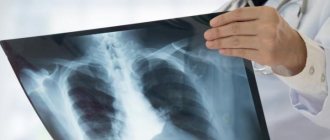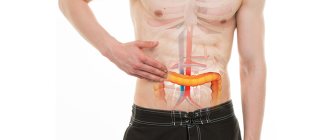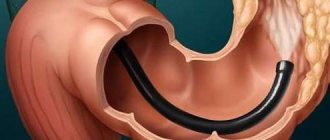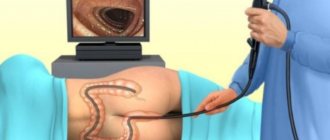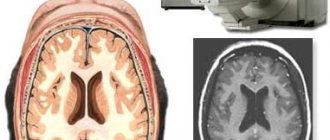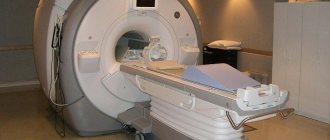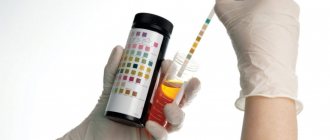Irrigoscopy is used as an alternative to computed tomography of the gastrointestinal tract. The method is simple, economical and effective. An examination of the intestine will help determine the neoplasm, the lumen and its size, features of the folds, and evaluate motility. The impact of radiation on humans is minimal. The special solution does not cause any acute discomfort. The whole process consists of preparing for the procedure and placing diluted barium sulfate into the intestines. Preparing for irrigoscopy requires the patient to be attentive. The examination takes less time than a colonoscopy. The result is ready almost immediately.
Irrigography makes it possible to see the features of the large intestine on an x-ray. This prevents gastric injury to the patient. Patients tolerate the effects more easily. The risk of complications is minimal. The intestines displayed on the monitor allow the patient to see the condition of the organ. If areas that alert the doctor are detected, an image is taken. An examination is included in the list of mandatory procedures for suspected colon cancer. The doctor analyzes the patient's medical history to identify possible contraindications.
What is irrigoscopy and why is it so important to prepare for it correctly?
Irrigoscopy is a method of examining the large intestine, which is prescribed to the patient if the attending physician cannot make a diagnosis by visual examination. Using irrigoscopy, you can diagnose various types of tumors, ulcers, etc.
There are two types of irrigoscopy:
- contrasting;
- double contrast.
The difference is that with the double method, air is injected along with the contrast agent. This allows for more detailed visualization.
The reliability of the results of irrigoscopy directly depends on how well the intestines are prepared for the examination.
Photo gallery
The radiology doctor will tell you how to properly prepare for irrigoscopy on the visus-1 channel.
Indications and contraindications for irrigoscopy
The main indications for the examination are the following reasons:
- feeling of pain or discomfort in the anus;
- suspicion of malignant neoplasms of the intestine;
- the presence of blood, mucous or purulent discharge in the stool;
- chronic intestinal disorders: constipation, diarrhea;
- colitis;
- acute intestinal obstruction.
The reasons why irrigoscopy is contraindicated are:
- pregnancy (due to the negative impact of x-ray radiation on the fetus);
- perforation of the intestinal walls;
- colitis in the acute stage;
- severe cardiovascular diseases.
Who is indicated for irrigoscopy?
Such an intestinal examination is prescribed if the patient presents the following complaints:
- pain in the anus, discharge or bleeding of unknown cause;
- frequent constipation/diarrhea of unknown etiology;
- suspicion of oncological processes in the large intestine;
- colitis, ulcers, other inflammations;
- diverticulitis;
- pain syndrome of unknown origin.
The painlessness and harmlessness of such a study does not “cancel” contraindications, which include pregnancy, intestinal perforation, states of shock and decompensated diseases of the cardiovascular system. Confirmed colitis in the acute stage also serves as an obstacle to the procedure.
Nutrition before irrigoscopy
An important part of the algorithm for preparing for the procedure at home is maintaining a proper diet. Experts recommend eating according to the principle of a slag-free diet, the main postulate of which is to consume easily digestible, low-calorie foods. It is necessary to completely exclude “heavy” dishes from the menu.
To understand the intricacies of a slag-free diet, you need to consider the following aspects:
- duration of the diet;
- permitted products;
- prohibited products;
- menu on the last day before the study.
How long to follow the diet
You should start following the diet three to four days before the date of the procedure. This is exactly how long it takes to cleanse the intestines and stomach.
Authorized products
The food consumed before irrigoscopy should be easily digestible, so it is recommended to adhere to the following menu:
- weak broths;
- White bread;
- berry and fruit compotes;
- boiled or steamed meat, fish;
- boiled rice;
- jelly, weak tea;
- semolina porridge;
- cheeses of various varieties;
- low-fat fermented milk products (with the exception of cottage cheese).
Prohibited Products
When following a slag-free diet, you should exclude the following foods from your diet:
- black bread;
- fruits and vegetables containing a lot of fiber;
- any carbonated drinks;
- strong tea, coffee;
- pasta, potatoes, legumes;
- oatmeal, pearl barley;
- hot, salty, spicy;
- fatty fish and meat.
Menu for the last day before the study
The day before the study, you must switch to liquid nutrition.
- vegetable soups;
- light fermented milk products.
And also drink as many liquids as possible:
- water;
- teas;
- dried fruit compotes (without pieces of fruit).
It must be remembered that the day before the irrigoscopy procedure you should not have dinner, but doctors allow replacing dinner with a glass of juice.
Preparing for irrigoscopy at home
It is inappropriate to keep the patient in a hospital setting during preparation for irrigoscopy. This procedure takes several days, so following the doctor’s instructions, the person can stay at home.
Of course, there are indications for urgent examination, but in the case of routine diagnostics, the preparatory stage can be carried out at home. To properly prepare the intestines for irrigoscopy, it is necessary to follow a slag-free diet for three to four days and perform cleansing procedures.
Usually the algorithm is described by the doctor supervising the patient. During a conversation with the patient, he explains the essence of the diet that a person must follow, and also explains the need to take laxatives and perform an enema before the manipulation.
Bowel cleansing before irrigoscopy
To cleanse the intestines before the procedure, you can resort to two methods:
- cleansing enemas;
- cleansing with medications.
Cleansing enemas
If the patient wants to choose to cleanse the intestines at home using enemas, he needs to remember that before barium enema the enema is done several times:
- before bed the day before the examination;
- after natural bowel movement;
- two hours before the procedure.
For the first time, about a liter of water is injected into the intestines with an enema. The procedure must be repeated until the emerging liquid becomes completely clean.
Medical cleansing
The process of cleansing the intestines can also be carried out with the help of specialized pharmaceutical preparations.
They have different shapes:
Most doctors recognize drug cleansing of the stomach and intestines as more effective than the traditional method involving the use of an enema.
Experts recommend using the following drugs to cleanse the intestines before irrigoscopy:
- Fortrans;
- Lavacol;
- Duphalac;
- Fleet Phospho-soda;
- magnesium sulfate.
Before you start taking medications, you should consult a specialist and read the instructions.
Fortrans
Fortrans (from 114 rubles per sachet)
The method of using Fortrans is as follows: it is necessary to dilute one sachet per kilogram of weight in the appropriate amount of still water (one liter per sachet). Next, the liquid must be drunk within 3-4 hours. The effect after taking the first dose of the drug occurs after an hour and lasts about six to ten hours. The effect of the drug is based on softening the intestinal contents.
Most patients who took Fortrans to cleanse the intestines noted an unpleasant taste of the drug. However, doctors often recommend this remedy because of its high effectiveness.
Lavacol
Lavacol (from 183 rubles per pack)
The drug is available only in powder form. It is recommended to dilute one sachet per 200 ml of water, however, to achieve the effect necessary when preparing for irrigoscopy, the patient needs to drink 3 liters of water (15 sachets).
Contrary to erroneous belief, Lavacol does not cause dehydration, since it does not suck water from the body, but swells due to the liquid that was taken along with the drug.
Duphalac
Duphalac (from 300 rubles per bottle)
The drug is available in the form of syrup. The advantage of this product is the absence of contraindications for use by nursing women and children. The action is based on softening stool. Duphalac is taken by the patient once after the last meal of the day before the examination (lunch). The recommended dose is 200 ml of syrup, diluted in a small amount of water.
Fleet Phospho-soda
Flit Phospho soda (from 637 rubles per pack)
A laxative based on salts, due to which water is retained in the body and intestinal motility is enhanced. Release form: oral solution. The first portion should be taken in the morning after breakfast, the day before irrigoscopy. One bottle of the drug is diluted in 120 ml of liquid and washed down with a glass of water.
The patient takes the second dose of the drug after dinner (replaced with a glass of juice); the bottle must be diluted and taken in the same way as the morning portion.
In between doses of the drug, you should drink plenty of water. In general, it is recommended to drink at least two and a half liters.
What can you drink before an intestinal x-ray?
A very important question is how much and what kind of liquid you need to drink while preparing for barium enema, and whether you can drink water immediately before the procedure. It is quite difficult to give a definite answer regarding fluid volumes, since each organism has individual needs for water. On average, experts recommend drinking at least 2 liters of fluid per day.
You can drink boiled water, weak green and black tea, hibiscus, water with lemon. The consumption of alcohol, coffee drinks and sparkling water is strictly prohibited. In the morning, the day before the procedure, you can drink a few sips of water to ease your condition. You should not overdo it with water, as the feelings associated with the procedure can cause weakness, dizziness or nausea.
Video
A short but informative video will help you understand the intricacies of the irrigoscopy procedure. Filmed by the channel Live Healthy!
7 minutes Author: Lyubov Dobretsova 34531
Diseases of the large intestine are not always easy to diagnose - their symptoms, especially some signs, may indicate many similar pathologies. To establish a diagnosis, primary manifestations are often not enough, and a thorough examination of the intestinal mucosa is required.
Irrigoscopy is considered to be the most suitable and convenient in many respects - an X-ray method of obtaining images of the colon for subsequent study. One of the main conditions for obtaining reliable results is high-quality preparation for intestinal irrigoscopy.
When is preparation necessary?
An examination based on the use of X-rays is carried out quickly and provides detailed, high-quality information regarding the organs being examined. Considering the length of the intestine and possible contraindications, due to which it is impossible to perform a direct examination from the inside using colonoscopy, barium enema is a worthy alternative.
As a result of irrigoscopy, the doctor receives a detailed picture of the intestine with possible morphological changes, neoplasms and various inflammatory processes. It is also possible to evaluate the size of the organ lumen, the length and structure of the folds, and its motility. Intestinal irrigoscopy, due to its wide ability to detect many diseases, is one of the primary and inexpensive methods, and is prescribed if the following are present:
- pain or discomfort in the groin area or anus;
- frequent disorders of the stomach and intestines - constipation or diarrhea;
- violation of the structure of the colon, diverticulosis, fistulas;
- bleeding from the anus or various discharges (pus, mucus);
- change in the shape and length of the intestine – dolichosigmoid;
- inflammatory processes, Crohn's disease;
- suspicion of the presence of a neoplasm;
- postoperative scars or adhesions.
This study of the colon is also used for monitoring after intestinal resection operations, to detect oncological relapses and to assess the independence of interintestinal anastomoses. High-quality preparation is one hundred percent guarantee of obtaining accurate results! The most important aspect on which irrigoscopy is based is scrupulous and well-executed preparation for the examination.
Almost all diagnostic methods used for the large intestine are based on the same principle - ideal cleanliness of the organ. Therefore, preparatory measures for this procedure are no different from those used for colonoscopy or irriography, which also allow a detailed study of the colon. So how to prepare for intestinal irrigoscopy so that you don’t have to do it again due to the inability to obtain the necessary data?
Slag-free diet
It is necessary to go on a slag-free diet 2 days before the appointed date of the study, that is, you will have to exclude foods that increase the formation of fecal matter and increased gas formation.
Such food products include:
- vegetables - beets, potatoes, cabbage, carrots, tomatoes, onions, peppers, herbs;
- fruits and berries - peaches, apricots, lemons, oranges, apples, bananas;
- porridge – millet, pearl barley, oatmeal;
- legumes - beans, lentils, beans, peas;
- wholemeal bread, bran, mushrooms.
For at least 2 days before the procedure, you are allowed to eat only waste-free food that does not lead to the formation of abundant feces and increased gas formation. If the patient does not know what he can eat during the preparatory period, he should take a memo from the nurse, which describes the entire algorithm in detail. Permitted products include broths, eggs, semolina porridge, boiled lean meats or fish, fermented milk products, except cottage cheese.
All foods subject to heat treatment should be boiled or steamed. The broth should not be too rich. On the eve of the examination, you can eat only light food at lunch, for example, boiled fish, fermented milk products or semolina porridge. It is forbidden to eat solid food for dinner, so it will consist of broth, kefir or fermented baked milk, yogurt, compote. Breakfast on the day of the examination will also only be liquid.
Nutrition before an X-ray of the intestines with barium
The first and one of the most important stages is to follow a special slag-free diet for several days, until the study. The point of this diet is to exclude from your diet foods that can cause increased fermentation and gas formation in the lumen of the large intestine.
You should avoid eating the following foods:
- sweets;
- bakery products;
- whole unprocessed milk;
- fat kefir;
- cottage cheese;
- beer;
- carbonated sweet drinks;
- beans;
- pasta;
- potato;
- wheat, pearl barley and oatmeal;
- fried and highly peppered meat;
- vegetables containing coarse fiber (cabbage, apples);
- coffee drinks.
To make it easier to create your own diet for these days, you can eat dietary meats, boiled or baked in the oven. Before cooking, cereals should be soaked in water for several hours, and after cooking, wrapped in warm towels to steam for half an hour.
In order to maintain normal intestinal functioning, it is recommended to consume vegetable salads; vegetables should be subjected to minimal heat treatment. You can drink water, green teas, rosehip decoction.
Purgation
To fulfill the most important condition of preparation for the procedure - to perfectly cleanse the intestines, two methods can be used, and the patient has the opportunity to choose the most acceptable one for himself. This is a familiar method for many and quite common due to its simplicity and economy.
For it you will need an Esmarch mug or a combination heating pad and slightly cool, maybe slightly salted or acidified water. The water temperature should not exceed 35–37 ºС, since warm water helps to dissolve fecal matter, which prevents its complete removal from the intestine.
On the eve of the diagnosis, at lunch you need to drink 2 tbsp. spoons of castor oil or 150 ml of a 30% solution of MgSO4 (magnesium sulfate), which will contribute to high-quality cleansing.
In the evening, after an independent act of defecation, you need to do two enemas at 20.00 and 22.00, and then in the morning at 7–8 o’clock on the day of the study, you need to repeat the enema.
Esmarch's mug must be filled with 1.5–2 liters of water. To ensure that the tip enters carefully and does not injure the anus, it should be lubricated with Vaseline or baby cream. After inserting the tip, you need to open the valve and water will begin to flow into the intestine. There is no need to apply a lot of pressure, as this can be painful for the intestines.
It will be quite difficult to carry out such a procedure yourself, so it is better to ask loved ones for help in this action. After introducing water, you need to lie down on one side, then on the other, for several minutes and repeat the procedure until the water used for rinsing becomes absolutely clean.
You can also add a decoction of herbs, such as chamomile, to ordinary water for washing the intestines. If cleaning with enemas is contraindicated (inflammatory process in the intestine, hemorrhoids), alternative methods that are safe for these diseases should be used.
Medical cleansing
Modern medicine currently offers a fairly large number of drugs with which you can perform high-quality intestinal cleansing without using enemas. Fortrans and Duphalac are considered the most common and easy-to-use products.
Fortrans
Cleaning with Fortrans, in addition to the positive aspects that ensure high-quality preparation of patients for the study, has not very pleasant aspects associated with the unpleasant taste of the diluted drug. Therefore, when using it, you can add orange or lemon juice to the solution. The drug contains ingredients that have the property of cleansing the intestines - macrogol, sodium bicarbonate, anhydrous sodium sulfate, potassium and sodium chloride.
The amount of the substance depends on body weight, that is, you need to purchase 1 sachet per 20–25 kg of the patient’s weight. If the procedure is planned the next morning, then lunch the day before should be no later than 14:00. You should start taking the drug from 16-17 hours. To prepare the solution, dissolve 1 sachet in 1 liter of water and drink it within an hour.
If the intake is accompanied by nausea, then you can suck on a slice of lemon after the next serving. In a situation where the procedure is planned after lunch, half of the required dose of the drug should be taken the night before at 18–19 hours, and the rest in the morning at 7–9 hours.
Duphalac
The drug is available in bottles, as it is in the form of a liquid. To clean, you need to dilute the entire contents of the container - 200 ml in 2-3 liters of water and take a glass of the resulting solution every 15 minutes. The entire prepared solution should be consumed within 2–3 hours. The urge to defecate will begin approximately 1-2 hours after the first drink.
Cleansing the stomach with medications
The drugs that are most popular for cleansing the intestines of contents in preparation for irrigoscopy have already been listed above. Below is basic information about each and a diagram of their use.
Fortrans
The action of this drug is aimed at softening the intestinal contents and loosening fecal stones, if any.
Side effects occur very rarely and do not cause heaviness or abdominal pain or increased gas formation.
Allowed during breastfeeding.
Contraindications include the following conditions:
- heart muscle disease;
- dehydration of the body;
- serious damage to the mucous membranes of various parts of the gastrointestinal tract;
- intestinal obstruction.
The dosage is calculated at the rate of one sachet of the drug per 20 kg of weight. That is, a person with average weight will need from 3 to 4 sachets of the drug. If the patient suffers from constant constipation or is overweight, the dose increases to 5-6 sachets.
The best option would be to start drinking Fortrans before irrigoscopy at 17-18 pm.
This laxative should be used according to the following scheme:
- Pour the contents of the bag into 1 liter of water and mix thoroughly (shake);
- the resulting solution must be consumed within an hour (the best way is to divide it into 4 parts and take the calculated amount every 15 minutes);
- half of the solution should be drunk before night at the specified time, the second - in the morning at 6-8 o'clock.
To simplify administration and get rid of nausea (a consequence of drinking large amounts of liquid), it is necessary to eat a slice of lemon after each serving of the solution.
The laxative effect of the drug ends approximately 3-4 hours after the last dose.
It is the most used remedy to cleanse the intestines before irrigoscopy.
Duphalac
This representative of laxatives is available in the form of a suspension. Effectively copes with the softening of intestinal contents. Safety indicators allow Duphalac to be used by both children and mothers during lactation.
The method of application is simple. The day before the diagnostic procedure, the drug is drunk after a lunch meal, or rather 2 hours after it.
The dose, of course, depends on the age of the patient; for adults it is 200 ml of suspension, which must be diluted in water before use. The effect usually occurs on average 2 hours after consuming Duphalac.
Lavacol
This laxative is produced by pharmaceutical companies in powder form. The dose for colon cleansing is 15 sachets, each of which requires 200 ml of water for dilution. That is, the total amount of solution that needs to be drunk to achieve the effect is 3 liters.
The product does not have the most pleasant taste, so it is possible to “ennoble” it. To do this, add fruit or berry syrup to the solution. An alternative would be jam, but without seeds.
If the diagnosis is scheduled for the morning, Lavacol should be taken before 21:00. If the doctor has prescribed intestinal irrigoscopy for the afternoon, preparation is carried out as follows: half of the solution is consumed in the evening, and the rest early in the morning (at about 6-8 am).
The drug has the lowest cost among those listed.
Fleet Phospho-soda
Salt-based laxative. Its properties allow it to retain water and promote the activation of peristalsis, which leads to the desired result.
Its effectiveness comes at a price: it is not recommended for the following groups of patients:
- having various dysfunctions of the liver and kidneys, as well as having a predisposition to them;
- elderly people;
- women during lactation.
While taking Fleet Phospho-soda, that is, the day before the x-ray, only broths and so-called clear drinks are consumed. A single dose is the contents of a bottle of medicine dissolved in 120 ml of water.
The regimen is as follows:
- the first dose is drunk immediately after breakfast (as already indicated, only broth can be consumed);
- the second dose is taken immediately after dinner, also consisting exclusively of broth.
Changes in the regimen of use are possible only if irrigoscopy is scheduled for the afternoon. In such cases, the first dose is taken at dinner the previous day, and the second at breakfast the next day.
In addition to drug cleansing of the intestines, there is also a method using exclusively enemas.
Doctors' recommendations
Despite the fact that the procedure does not involve surgery or any other type of damage, the doctor should definitely take into account possible contraindications that the patient has.
Factors under which research is prohibited include:
- severe general condition of patients;
- heart failure;
- intestinal obstruction;
- ulcerative colitis, cyst;
- arterial hypertension;
- diarrhea accompanied by blood;
- suspicion of intestinal perforation.
Irrigoscopy is also contraindicated for pregnant women, nursing mothers and children, although an exception is made for breastfeeding women in certain cases. If you take into account all aspects of the examination - timely appointment, training and professionalism of the doctor, then you can obtain reliable results with 100% confidence, facilitating the rapid establishment of the correct diagnosis.
Available contraindications
When preparing for the intestinal irrigoscopy procedure, it is very important to familiarize yourself with the list of contraindications.
However, you should still refuse it in the following cases:
- general serious condition of the patient;
- existing cysts and ulcers;
- loose stools with blood clots;
- heart failure;
- intestinal perforation or suspicion of its presence.
It is also worth remembering that no matter how effective the preparation for irrigoscopy, the procedure is prohibited for pregnant women, small children and nursing mothers, although exceptions can be made for the latter in rare cases.
Intestinal irrigoscopy: diagnosis, preparation, indications, contraindications.
Modern medicine uses a huge variety of diagnostic techniques that allow us to examine and promptly identify various diseases. In relation to an organ such as the intestine, the procedure of irrigoscopy is most often used - a popular and very informative technique.
So, let's try to figure out what intestinal irrigoscopy is, in what cases is it used and how effective is it?
Colon irrigoscopy is an X-ray technique for examining the colon, during which a contrast agent (barium sulfate) is injected through the rectum.
During intestinal irrigoscopy, you can see the shape and diameter of the lumen of the colon, the location and degree of stretching of the walls of the organ, and the bauhinium valve, which controls the process of passage of intestinal contents from the ileum to the colon and prevents its backflow. The study allows you to assess the condition of different parts of the colon, which is extremely necessary when diagnosing ulcers, fistulas, diverticulosis, tumors, etc.
The procedure for intestinal irrigoscopy is not only absolutely painless, but, unlike intestinal colonoscopy, it does not even involve the occurrence of any unpleasant sensations.
Indications and contraindications for intestinal irrigoscopy
Irigoscopic examination is prescribed when the patient has the following complaints:
- periodic bleeding from the rectum;
- pain in the anus and along the colon;
- mucous or purulent discharge from the rectum;
- chronic diarrhea or constipation.
The study allows you to dispel all doubts, confirm or refute the doctor’s preliminary diagnosis, and if you suspect intestinal cancer complicated by a hereditary predisposition, it is an extremely effective diagnostic measure.
The intestinal irrigoscopy procedure cannot be prescribed if at least one of the contraindications is present (tachycardia, heart failure, perforation of the colon walls, pregnancy, inflammatory diseases). Otherwise, the proctologist is forced to choose another diagnostic technique that does not involve such contraindications.
How to prepare for intestinal irrigoscopy?
This method of examining the intestines requires some preparation, because in order for irrigoscopy to be as informative as possible and nothing to hinder the administration of a contrast agent, it is necessary to cleanse the organ of feces. A few days before the examination, it is necessary to exclude from the diet those foods that can provoke heavy stool or bloating (fresh vegetables and fruits, herbs, pearl barley, oatmeal and millet quiches, bread). It is better to use a double boiler for cooking these few days and not make the dishes too fatty. If the examination is scheduled for the morning, then the day before you can only have lunch; dinner and breakfast should be completely excluded. It is also recommended to cleanse the intestines using cleansing enemas (until the stool disappears) or special laxatives, the use of which should be consulted with a doctor.
How is the procedure and preparation for intestinal irrigoscopy?
The duration of the procedure is no more than 45 minutes and, as mentioned earlier, does not involve the occurrence of pronounced pain. Most often, the session takes no more than 15-20 minutes, because the technique of irrigoscopy has been polished over the years and improved to the maximum. When the preliminary preparation stage is completed, the first overview photograph of the abdominal organs is taken.
The so-called contrast agent (barium sulfate) is mixed with water in certain proportions and heated to a temperature of 35C. Using a special device, the substance is injected into the patient’s intestines. In order for the substance to be evenly distributed throughout the intestine, the patient must periodically turn on his stomach, on his right and left side. As the contrast is introduced, several pictures are taken again, another one is taken when the barium is completely broken down, and the final one is taken after the tube is removed and the patient has evacuated the intestines. This allows you to evaluate the relief features of the intestinal mucosa and the functional activity of the organ. After this, the intestines are filled with air, taking another series of pictures. Since the intestinal walls are covered with a layer of contrast and straighten out much better than at the very beginning of the irrigoscopy procedure, the structure of the organ and even the smallest tumors, ulcers or polyps become visible much better. This method is called double contrast and is a fundamental technique in the diagnosis of colon cancer.
Possible complications
Most likely, for several days the patient will not have stool at all, and if he does, the stool will become light in color due to barium. If necessary, the patient is given an enema or given a laxative, but this can only be done under the supervision of a doctor who performed intestinal irrigoscopy. If the procedure was performed correctly, taking into account all the features and subtleties, you should not expect any complications to arise. Only in rare cases are such unpleasant surprises possible, such as perforation of the intestinal wall, the formation of barium granulomas or barium embolism, or accidental entry of a contrast agent into the abdominal cavity.
Article on the topic: “Intestinal irrigoscopy: diagnosis, preparation, indications, contraindications.” is provided for general informational purposes only and is not a substitute for professional medical advice. Subscribe to our VKontakte group!
Features of the preparatory stage
Your attending physician will best tell you how to prepare for intestinal irrigoscopy. He will select medications if preference is given to medicinal cleansing of the organ and draw up an approximate menu. The recommendations developed by a specialist must be strictly followed, otherwise the results will not be clear and a repeated approach will be required.
Slag-free diet during preparation
First of all, you need to find out what you can eat before irrigoscopy, and what you will have to give up. A profile diet is a fairly effective cleansing technique. It will help remove excess feces, stagnant waste, toxins and excess fluid from the body.
A slag-free diet before irrigoscopy looks like this:
Three days before the session, you need to give up foods that overwhelm and stretch the intestines and become a source of abundant gases. This includes greens, vegetables and fruits.
- It is prohibited to drink alcohol, carbonated drinks, or black coffee.
- Black and coarse bread, buckwheat and oatmeal porridges are prohibited.
- You should not eat smoked, fried or fatty foods. Food should be steamed, boiled, or baked in the oven.
- During this period, you can eat white meat, lean fish, fermented milk products and broths in second water. For variety, it is allowed to add white bread croutons, rice porridge, and dry unsweetened cookies to the menu.
- You can drink a lot of water, green tea, compotes and herbal teas, in almost unlimited quantities. The restriction is imposed only on those who are sick and excessive stress on the kidneys is unacceptable.
- On the eve of irrigoscopy, lunch should be light; it is better to skip dinner. Instead, we drink water and green tea. The next morning, no breakfast, liquids - at the discretion of the doctor.
Many people mistakenly think that such preparation for the procedure is sufficient. In fact, special nutrition is one of two mandatory points. The algorithm of actions changes only in emergency situations, when there is no time for preparation and diagnostics must be carried out very urgently.
Enema – to do or not to do?
Previously, it was possible to cleanse the intestines before irrigoscopy only with enemas. Today, patients have a choice, and they may prefer another option to rid the digestive tract of all unnecessary things. And yet, many today prefer this approach, especially if the procedure is required by a diabetic and forced fasting can cause negative consequences.
If you choose an enema, the procedures are carried out in the evening before the session and in the morning on the day of its implementation. It is recommended to give two enemas the day before, an hour apart. Before the first session, you should take 1-2 teaspoons of castor oil. The volume of liquid should not exceed 1.5 liters at a time. Manipulations are carried out until the wash water is clean.
Benefits of Medication Preparation
Today, in order to prepare for an X-ray of the intestine, it is possible to limit yourself to taking special medications. Despite the fact that detailed instructions are attached to each of them, we prepare exclusively according to the scheme proposed by the proctologist. Compliance with its recommendations is the basis for successful diagnosis.
Here are the options for drug preparation for irrigoscopy:
| Name | Admission rules | Peculiarities |
| Fortrans | Not everyone likes colon cleansing with Fortrans, since you need to take 4 liters of liquid. One sachet of the composition is diluted in 1 liter of warm water and drunk in slow sips. This is done the day before the session. | Fortrans before irrigoscopy can cause a gag reflex. This will not happen if you eat a slice of lemon after each liter. |
| Lavacol | Cleaning with Lavacol involves drinking 3 liters of liquid. The process begins 15-20 hours before irrigoscopy. | The drug is better tolerated due to its salty taste. |
| Fleet | A day before the session, you need to dissolve the contents of the bottle in 100 ml of water, drink it and wash it down with another glass of clean liquid. In the evening of the same day, the manipulation is repeated. | You will have to give up lunch and dinner on the day you take the medicine. |
| Duphalac | After lunch on the eve of the session, drink 200 ml of syrup and wait for the reaction, which will occur in 1-3 hours. | Some doctors do not recommend the approach due to the risk of gas formation. |
. Also, you should not take Fortrans when a specialist has recommended Flit or another specialized drug. If the cleaning carried out led to a deterioration in the patient’s condition or the appearance of side effects, the decision to conduct a diagnosis is made by the diagnostician.
You should not practice medicinal options for bowel cleansing before irrigoscopy if the doctor insists on performing enemas
How is intestinal irrigoscopy performed for hemorrhoids?
Medicine, like other sciences, does not stand still. Diagnostic methods are being developed and treatment of various diseases is being improved.
Today, coloproctologists have a large number of additional examination methods in their arsenal, which doctors actively use to make a diagnosis, because many intestinal diseases have similar clinical manifestations.
The main complaints presented by the patient at an appointment with a specialist: pain, problems with stool (diarrhea or constipation), bloating and discharge from the rectum (mucus, blood or pus).
Despite the variety of diagnostic techniques, irrigoscopy remains one of the most common methods for detecting diseases of the large intestine.
Most likely, every patient with similar problems has more than once had questions of the following nature. What is irrigoscopy? In what cases is irrigoscopy prescribed? What should be the preparation before the study and is it needed at all? How is it carried out? Is intestinal irrigoscopy indicated for hemorrhoids?
In this article we will try to answer the main questions associated with this diagnostic procedure.
What is intestinal irrigoscopy?
Irrigoscopy #8212; This is an x-ray method for examining the large intestine, which is performed using a contrast agent, most often barium.
This diagnostic method is quite informative and not technically simple.
Intestinal irrigoscopy allows you to determine the shape and location of absolutely all parts of the large intestine, assess the condition of the intestinal wall and the functional characteristics of the entire colon, as well as identify formations in the lumen of the organ (tumors, polyps, diverticula), defects of the mucous membrane (ulcers, fistulas) and the presence of congenital pathology of the intestinal tube (elongated loop of intestine, etc.).
Exit from the diet: what to eat after irrigoscopy?
Liquid nutrition, like the barium enema itself, can greatly lower blood sugar levels, so immediately after the procedure you should drink tea with sugar or honey. Don't suddenly switch to regular products. Food containing hard ingredients will inevitably cause digestive disorders and cause constipation.
About a few hours after irrigoscopy, you can eat vegetable puree soup and rice soufflé. But it is best, without leaving the medical facility, to ask your doctor for individual recommendations regarding what you can eat after irrigoscopy. After all, if the results of the procedure reveal a volvulus, then you will have to give up normal food for quite a long time.
When switching to a normal diet, constipation may develop. If you do not feel any additional discomfort or pain, then you can do a microenema (Mikrolax is suitable). But it is better to first try folk laxatives (kefir, prunes, castor oil).



